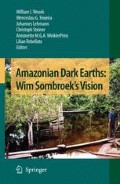As described elsewhere in this volume and in previous publications (Woods and McCann 1999; Lehmann et al. 2003; Glaser and Woods 2004), Amazonian Dark Earths (ADEs) are a continuum of organically rich soils found in patches throughout the Amazon basin. The growing literature on these soils is convincingly demonstrating the importance of ADEs to smallholders of today as well as helping to reconceptualize the prehistory of the region. We know what the soils are, what they look like today from a pedologic, chemical, and microbial perspective, and we know how productive they can be. What is still poorly understood is how they were created in the first place. Research on this is beginning, particularly by considering modern analogs such as ‘sweep and char’ behaviors in caboclo (Amazonian mestizo) homegardens. What this chapter sets out to do is to discuss sweeping and charring in present-day homegardens and to explore descriptions of such behaviors in domestic spaces in the literature (past and present) in order to contextualize the behavior as observed today.
Access this chapter
Tax calculation will be finalised at checkout
Purchases are for personal use only
Preview
Unable to display preview. Download preview PDF.
References
DeBoer WR, Lathrap DW (1979) The making and breaking of Shipibo-Conibo ceramics. In: Kramer C (ed) Ethnoarchaeology: Implications of Ethnography for Archaeology. New York: Columbia University Press, pp. 102–138
Denevan WM (2001) Cultivated Landscapes of Native Amazonia and the Andes. Oxford: Oxford University Press
Denevan, WM (2004) Semi-intensive pre-European cultivation and the origins of anthropogenic Dark Earths in Amazonia. In: Glaser B, Woods WI (eds) Amazonian Dark Earths: Explorations in Space and Time. Berlin: Springer, pp. 135–143
Erickson C (2003) Historical ecology and future explorations. In: Lehmann J, Kern DC, Glaser B, Woods WI (eds) Amazonian Dark Earths: Origin, Properties, Management. Dordrecht, The Netherlands: Kluwer, pp. 455–500
Heckenberger MJ (2005) The Ecology of Power. New York: Routledge
Hecht SB (2003) Indigenous soil management and the creation of Amazonian Dark Earths: Implications of Kayapó practices. In: Lehmann J, Kern DC, Glaser B, Woods WI (eds) Amazonian Dark Earths: Origin, Properties, Management. Dordrecht, The Netherlands: Kluwer, pp. 355–372
Hecht SB, Posey DA (1989) Preliminary results on soil management techniques of the Kayapó Indians. Advances in Economic Botany 7: 174–188
Hiraoka MS, Yamamoto S, Matsumoto E, Nakamura S, Falesi IC, Ronaldo A, Baena C (2003) Contemporary use and management of Amazonian Dark Earths. In: Lehmann J, Kern DC, Glaser B, Woods WI (eds) Amazonian Dark Earths: Origin, Properties, Management. Dordrecht, The Netherlands: Kluwer, pp. 387–406
Lehmann J, Kern DC, Glaser B, Woods WI (eds) (2003) Amazonian Dark Earths: Origin, Properties, Management. Dordrecht, The Netherlands: Kluwer
Madaleno I (2000) Urban agriculture in Belém. Cities 17(1): 73–77
Murphy Y, Murphy RF (1985) Women of the Forest. New York: Columbia University Press
Sillitoe P (1998) Knowing the land: Soil and land resource evaluation and indigenous knowledge. Soil Use and Management 14: 188–193
Smith NJH (1996) Home gardens as a springboard for agroforestry development in Amazonia. International Tree Crops Journal 9(1): 11–30
Thrift N (1985) Flies and germs: A geography of knowledge. In: Gregory D, Urry J (eds) Social Relations and Spatial Structures. New York: St. Martin's Press, pp. 367–403
Verswijver G (1996) Mekrãnoti: Living Among the Painted People of the Amazon. Munich: Prestel
Wagley C (1953) Amazon Town: A Study of Man in the Tropics. London: Oxford University Press
WinklerPrins AMGA, de Souza PS (2005) Surviving the city: Urban homegardens and the economy of affection in the Brazilian Amazon. Journal of Latin American Geography 4(1): 107–126
Woods WI, McCann JM (1999) The anthropogenic origin and persistence of Amazonian Dark Earths. In: Caviedes C (ed) Yearbook 1999 — Conference of Latin Americanist Geographers 25. Austin, TX: University of Texas Press, pp. 7–14
Editor information
Editors and Affiliations
Rights and permissions
Copyright information
© 2009 Springer Science + Business Media B.V
About this chapter
Cite this chapter
Winklerprins, A. (2009). Sweep and Char and the Creation of Amazonian Dark Earths in Homegardens. In: Woods, W.I., Teixeira, W.G., Lehmann, J., Steiner, C., WinklerPrins, A., Rebellato, L. (eds) Amazonian Dark Earths: Wim Sombroek's Vision. Springer, Dordrecht. https://doi.org/10.1007/978-1-4020-9031-8_10
Download citation
DOI: https://doi.org/10.1007/978-1-4020-9031-8_10
Publisher Name: Springer, Dordrecht
Print ISBN: 978-1-4020-9030-1
Online ISBN: 978-1-4020-9031-8
eBook Packages: Earth and Environmental ScienceEarth and Environmental Science (R0)

